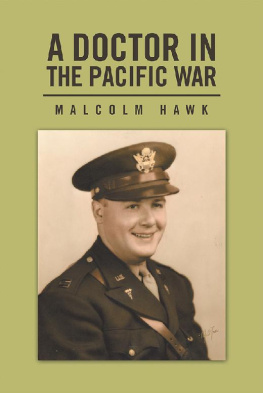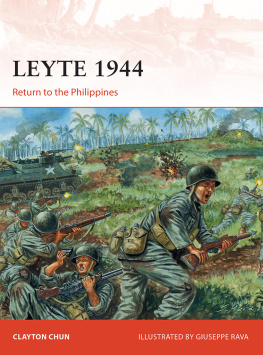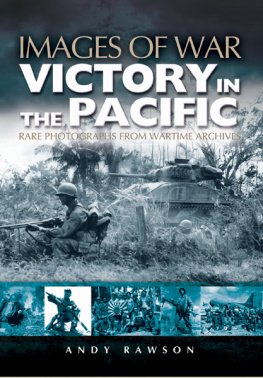A DOCTOR IN THE
PACIFIC WAR
Malcolm Hawk
Copyright 2020 by Malcolm Hawk.
Library of Congress Control Number: 2020904104
ISBN: Hardcover 978-1-7960-9061-1
Softcover 978-1-7960-9060-4
eBook 978-1-7960-9059-8
All rights reserved. No part of this book may be reproduced or transmitted
in any form or by any means, electronic or mechanical, including photocopying, recording, or by any information storage and retrieval system,
without permission in writing from the copyright owner.
The views expressed in this work are solely those of the author and do not necessarily reflect the views of the publisher, and the publisher hereby disclaims any responsibility for them.
Any people depicted in stock imagery provided by Getty Images are models,
and such images are being used for illustrative purposes only.
Certain stock imagery Getty Images.
Rev. date: 02/27/2020
Xlibris
1-888-795-4274
www.Xlibris.com
798619
CONTENTS
In August 1942, Malcolm Henry Hawk left a promising post-doctoral residency in anesthesiology at the University of Wisconsin Medical School to begin serving his country in the Pacific Theater during World War II. He left behind his young wife Margaret and their first child, a son named D avid.
In the early part of his service, he was at a series of camps in the United States, and was able to spend some time with Margaret and David. But in October 1943 he was sent overseas, and Margaret and David returned to her parents home in Sharon, Pennsylvania for the duration of the war.
This book contains relevant sections from the wartime letters he sent to Margaret, David, and other relatives during his Army service (leaving out the many endearments that appeared in every letter to Margaret, as well as irrelevant matters such as questions and comments about mutual friends and everyday housekeeping mat ters).
In the Pacific, he was with the 44 th General Army Hospital, first in Australia and then in the Philippines. The work was essential and often hard; the medical staff treated frontline casualties and also kept the support troops in each area hea lthy.
After the war, the World War II U.S. Medical Research Center published a vivid description of some of the challenges faced by U.S. Army medical personnel during the Pacific War:
The war against Japan was fought in an immense area that covered roughly 1/3 of the earths surface. Distances were enormous, and everything could only be moved by sea or air. In addition to combat casualties, environmental conditions brought characteristic medical consequences such as trench-foot, malaria, fever, and jungle rot; although these diseases were not normally fatal, they could nevertheless put soldiers out of action as effectively as combat casualties.
Until the very last months of the fighting, the US Medical Department faced immense obstacles supply lines were tenuous and environmental conditions almost intolerable, logistical difficulties beset medical planners, diseases took their toll, medical support often broke down, amphibious medical evacuation had to be revised, and yet altogether death rates from disease were only slightly over 1 / 1000 troops / per year.
Malcolm was fortunate to be seldom in danger, although he mentions being uncomfortably close to a few Japanese attacks in the Philippines. But what often came through most clearly in the letters were the frequent boredom; the endless hours of movies or poker or cribbage to fill the time; the loneliness of missing his family; the constant yearning for letters from home; the rigors of tent life and searing heat and monsoon rains and constant mud; the tantalizing nature of rumors and the frustrations of not being kept informed by the Army about possible moves or future postings or promotions; and worries about what he would do after the war was over and he came home to resume his ca reer.
But as thousands of other men and women did, he did his duty and then happily put it behind him. He seldom talked about the war in future years. Our aim in this book is to preserve an important part of his life for the family rec ords.
1908 Malcolm Henry Hawk born in Mansfield, Ohio, to Fred Hawk and Rosemary Hawk
1926 Graduated from Mansfield High Sc hool
1926 Matriculated at Wittenburg Collage, Springfield, Ohio
1930 Matriculated at Jefferson Medical School, Philadelphia, Pennsylv ania
1934 Established general medical practice in Austintown, Ohio
1935 Met Margaret Lytle at lakeside d ance
1936 Married Margaret Lytle in Sharon, Pennsylv ania
1940 Moved to Madison, Wisconsin to begin a post-doctoral program in advanced anesthesia with Dr. Ralph Waters, head of Anesthesiology Department at the University of Wisconsin Medical School. Dr. Waters was legendary in his field, credited with launching the modern era in anesthesiology. Before Ralph Waters arrived at the University of Wisconsin Medical School in 1927, instruction in anesthesia was nonexistent, and the field was practiced by only a few self-taught men. He created the first academic program of anesthesiology in the United States and established the first resident training program in anesthesia, in which Malcolm was enrolled when he was dra fted.
1942 Birth of first son, Malcolm David Lytle Hawk
1942 Drafted into the US Army Medical C orps
1942-1945 Served in the US Army. In the early years, at U.S. army bases; sent overseas to the Pacific Theater in October 1943.
1945 Received honorable discharge from US Army
1946 Continued anesthesia training at Mad ison
1946 Moved to California and joined The Associated Anesthesiologists in Palo Alto. According to the groups website in 2019 ( https://associatedanesthesiologistspaloalto.com ), The Associated Anesthesiologists is the oldest existing anesthesiology group in the Palo Alto area. In 1949, the group was operating as a clinical team serving the Palo Alto Hospital and in 1959 it became part of the original staff of the Palo Alto-Stanford Hospital when the Stanford Medical School moved from San Francisco to Palo Alto.
1948 Birth of second son, Charles Frederick Hawk
1950 Moved to 428 Maple Street, Palo Alto
1959 Affiliated with Stanford University Medical School as an associate professor when The Associated Anesthesiologists became part of the Palo Alto-Stanford Hosp ital.
1968 retired from medical practice. Continued to live at 428 Maple Street in Palo Alto with his wife Margaret until his d eath.
1976 Died suddenly of a massive heart attack while visiting his brother-in-law Charles Lytle in Sharon, Pennsylvania, just after attending his 50 th high school reunion in Mansfield, Ohio

A typical field hospital in the Pacific Theater in World War II
WORLD WAR II
LETTERS FROM MALCOLM
H. HAWK TO HIS FAMILY,
1942 - 1945
8/8/42 Rockford, Illinois Telegram: Passed physical, 24-hour delay Camp Grant. To Omaha ton ight.
8/9/42 Omaha, Nebraska - Got in here at 7:30 this a.m. and was so dirty that I checked into a hotel to get clean. About nine, I reported to headquarters but the officer I should report to was not in today, so I am to join tomorrow a.m. So I will have the day to myself and do not mind a bit.
As I said in the telegram, I was held at Camp Grant 24 hours until all the laboratory work was completed. There is a new officer in charge and he is a stickler for form so would not clear me. The officer previous to this one would have let me go. However, it worked out all right. I slept in a tent at camp and had a good time. Saw all the boys from Madison: Westover, Shapiro, Kohler, Schott, Larson, Sims and Town send.
Next page








